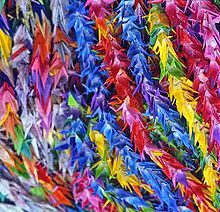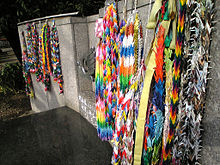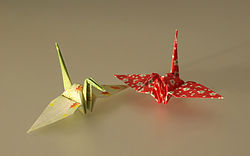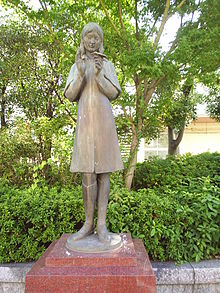- Thousand origami cranes
-
For the novel by Yasunari Kawabata, see Thousand Cranes.For the non-fiction story book about Sadako Sasaki written by Eleanor Coerr, see Sadako and the Thousand Paper Cranes.
Thousand origami cranes (千羽鶴 Senbazuru) is a group of one thousand origami paper cranes (鶴 tsuru) held together by strings. An ancient Japanese legend promises that anyone who folds a thousand origami cranes will be granted a wish by a crane, such as long life or recovery from illness or injury. The crane in Japan is one of the mystical or holy creatures (others include the dragon and the tortoise), and is said to live for a thousand years. In Japan, it is commonly said that folding 1000 paper origami cranes makes a person's wish come true. (expansion needed) This makes them popular gifts for special friends and family.
Contents
Cultural significance
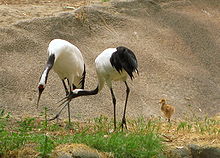 The Japanese crane (丹頂)
The Japanese crane (丹頂) Statue in memory of Sadako Sasaki in Hiroshima
Statue in memory of Sadako Sasaki in Hiroshima
A thousand paper cranes are traditionally given as a wedding gift by the father, who is wishing a thousand years of happiness and prosperity upon the couple. They can also be gifted to a new baby for long life and good luck. Hanging a Senbazuru in one's home is thought to be a powerfully lucky and benevolent charm.
Sets of origami paper are sold widely in Japan, with Senbazuru sets including 1000 (or more, in case of mistakes) sheets of paper, string, and beads to place at the end of each string to stop the cranes from slipping off.[1] Commonly the cranes are assembled as 25 strings of 40 cranes each.[1] The size of the origami paper does not matter when assembling a thousand paper cranes, but smaller sheets consequently yield smaller and lighter strings of cranes. The most popular size for Senbazuru cranes is 75 by 75 millimetres (3.0 × 3.0 in). Some people cut their own squares of paper from anything available, such as magazines.
Origami paper used for Senbazuru is usually of a solid color, though printed designs are also available. Larger size origami paper, usually 6x6 inches, often has traditional Japanese or flower designs, reminiscent of kimono patterns.
The Thousand Origami Cranes has become a symbol of world peace[citation needed] through the story of Sadako Sasaki, a Japanese girl who tried to stave off her death from leukemia as a result of radiation from the atomic bombing of Hiroshima during World War II by making one thousand origami cranes, having folded only 644 before her death, and that her friends completed and buried them all with her. (This is only one version of the story. Hiroshima Peace Memorial Museum states that she did, in fact, complete the 1,000 cranes.)
Her story is told in the book Sadako and the Thousand Paper Cranes. Several temples, including some in Tokyo and Hiroshima, have eternal flames for World Peace. At these temples, school groups or individuals often donate Senbazuru to add to the prayer for peace. The cranes are left exposed to the elements, slowly dissolving and becoming tattered as the wish is released. In this way they are related to the prayer flags of India and Tibet.
In Western countries, the custom has been extended from giving a senbazuru to cancer patients, to using them at funerals or on the grave.
Renzuru
The term renzuru refers to an origami technique whereby one folds multiple cranes from a single sheet of paper (usually square), employing a number of strategic cuts to form a mosaic of semi-detached smaller squares from the original large square paper. (Unlike Western origami purists, traditional Japanese origami often uses paper cuts to add detail such as ears.) The resulting cranes are attached to one another (e.g., at the tips of the beaks, wings, or tails) or at the tip of the body (e.g., a baby crane sitting on its mother's back). The trick is to fold all the cranes without breaking the small paper bridges that attach them to one another or, in some cases, to effectively conceal extra paper.
Typical renzuru configurations include a circle of four or more cranes attached at the wing tips. One of the simplest forms, made from a half square (2x1 rectangle) cut halfway through from one of the long sides, results in two cranes that share an entire wing, positioned vertically between their bodies; heads and tails may face in the same or opposite directions. If made from paper colored differently on each side, the cranes will be different colors.
This origami technique was first illustrated in one of the oldest (1797) known origami books, the Hiden Renzuru no Orikata. (Updated diagrams from this early work can be found in a current book by Japanese origami author Kunihiko Kasahara.)
Notes
- ^ a b Tinishiny.com, accessed April 2008
See also
- Children's Peace Monument
- Kunihiko Kasahara (See Vol. 3 of his listed publications)
- Sadako Sasaki
- Sadako and the Thousand Paper Cranes
Categories:- Origami
- Japanese culture
- Peace symbols
Wikimedia Foundation. 2010.

